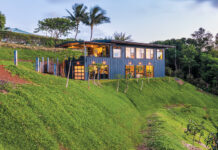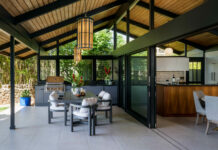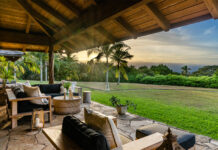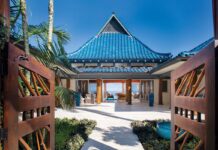Story by Lara McGlashan
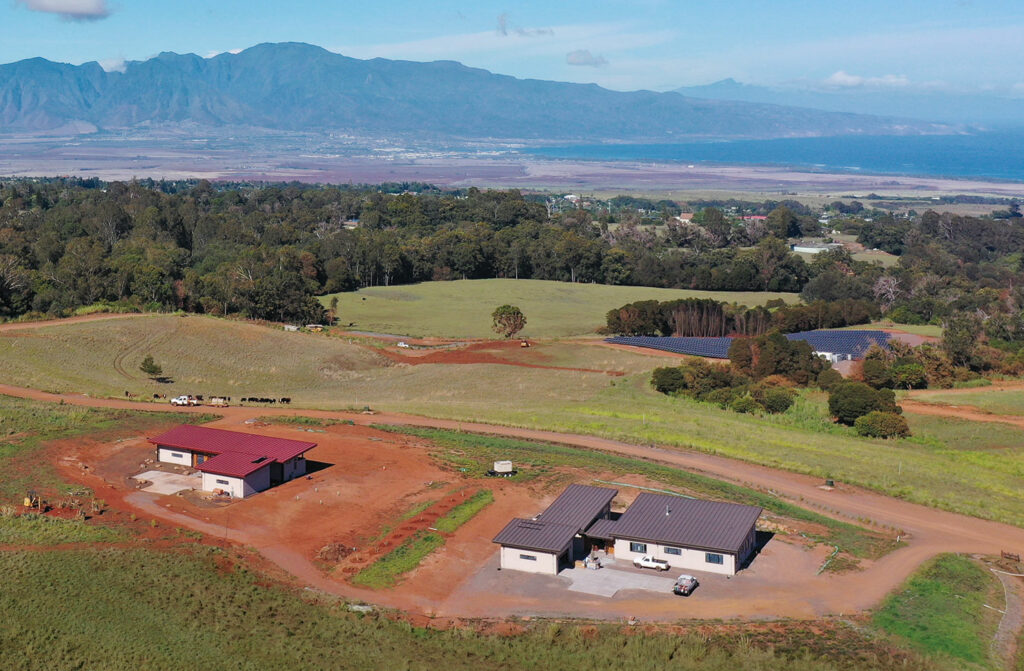
Just above Makawao Town lie 258 acres of rolling green terrain. Centuries ago, this was a diverse forest of koa, ‘ōhi‘a (a flowering evergreen) and olopua (Hawaiian olive) trees, but over time the land was transitioned to agricultural use for the production of sugar, pineapple and beef. Today, sugar and pineapple are gone, but ranching persists: Cows graze serenely to the left, sheep to the right, and chickens front and center as they survey the field to be picked over and fertilized, often simultaneously.
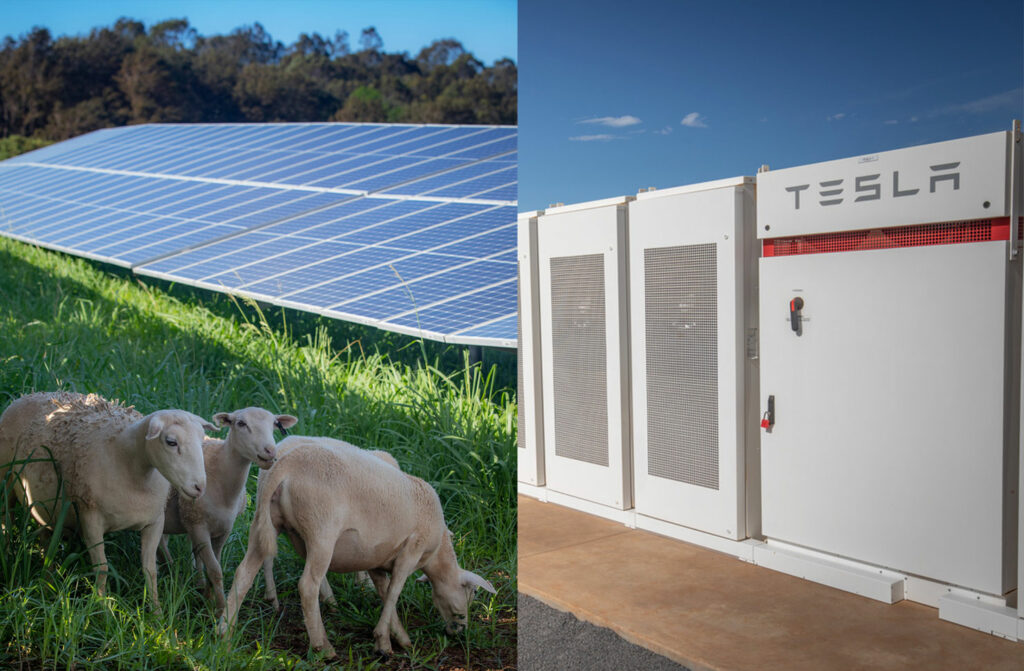
Look closer and you’ll see some signs of change: a fire hydrant sprouts from the landscape here and there, a winding roadway wraps around a series of ponds, and through the trees, a hillside of sleek solar panels sparkles in the sun. Nēnē (Hawaiian geese) waddle into a collection pond and a flock of finches tilts and slices in formation through the sky. This is Hōkū Nui, a regenerative agricultural community that integrates eco-friendly living with culture, forestry and animal husbandry, where all the elements in the community — the people, land, plants, animals, water and energy — support one another symbiotically.
The project was originally inspired by Karin Frost and her brother Erik, long-time environmental advocates committed to the restoration of the area with the mission of adopting regenerative farming techniques, reforestation practices and, ultimately, resource independence.
“Regenerative agriculture is one of the most prolific and growing trends in sustainability,” says Jim Hammett, CEO of Hōkū Nui. “It is the next step some farmers are taking to sustain and improve the environment.” And indeed, the backbone of Hōkū Nui is regenerative farming, a system of agricultural operations and grazing practices which works to rebuild the organic and microbial matter in the soil while also rehabilitating the overall ecosystem of an area. This is accomplished with a calculated rotation of grazing animals to ensure the grass and soil are being improved upon rather than stripped and depleted, as with conventional farming. “The underlying goal of our agricultural operation is to increase the biodiversity of the soil,” says Nicholas Sickles, Hōkū Nui director of farm operations. “This foundation leads to increased resilience in forage for our grazing animals, supports future farming and native-reforestation efforts and increases soil permeability.”
Hōkū Nui employs a number of other regenerative practices such as keyline plowing, (a no-till method wherein thin lines are cut into the soil to increase water filtration and more evenly distribute water), and the production of natural fertilizer made from animal manure, green farm waste and composting. The architecture of the landscape itself was carefully analyzed, and builders designed the infrastructure and roadways to help capture the rainfall and funnel it from watersheds into large storage ponds for agricultural and non-potable use.
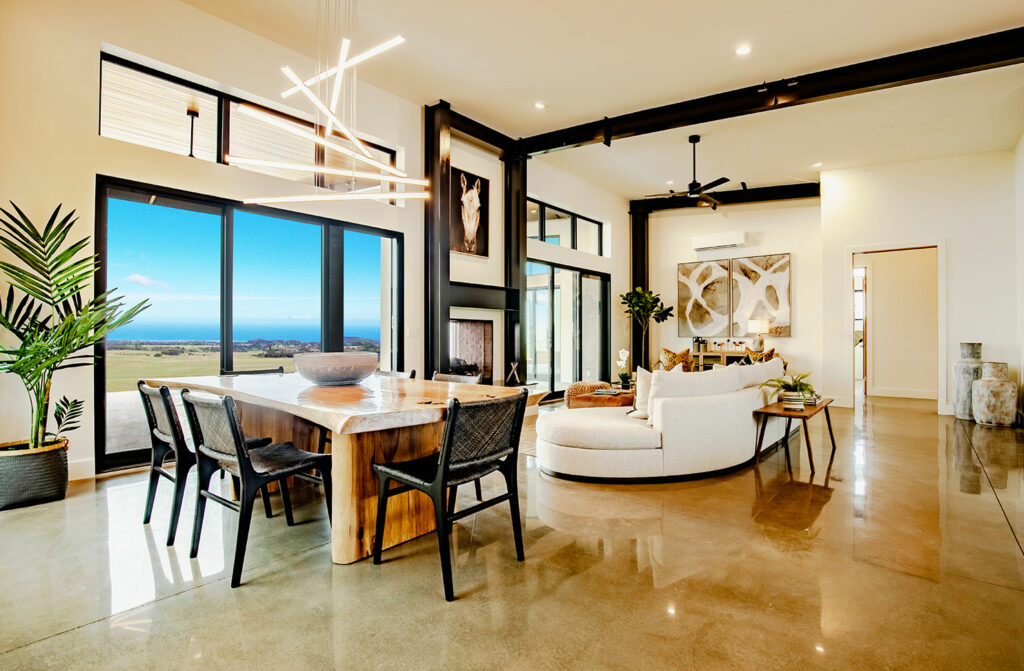
Since farming and ranching are the mainstays of the Hōkū Nui community, a butchery was constructed to service the animals raised on-property. It is also available to neighboring farmers, who to date have had to ship their livestock to the mainland for processing, and will enable greater food security and economic support for Maui. And this summer, Hōkū Nui will open a food hub, designed by culinary venue artist Bill Kohl, which includes a store, pizza oven, community garden and farm-to-table food truck.
The ultimate goal of Hōkū Nui is to be fossil-fuel-free. “The microgrid [solar] system provides one megawatt of generated power, with three megawatts of storage utilizing Tesla batteries,” says Hammett. “And the well provides 1.7 million gallons per day; Hōkū Nui has a need for less than 250,000 gallons per day at full occupancy.” Hammett hopes to work with Maui County to share any excess resources with the community.
The reach of Hōkū Nui extends well beyond farming and ranching, however, and the founders wish to manage the land in the Hawaiian style and spirit of stewardship as opposed to ownership. This in mind, 20-some acres have been dedicated to Polynesian-style native forest restoration which involves companion planting of short-term food producing plants with long-term native trees. This blend of native and canoe crops (those that were brought to the Islands by the original settlers) helps them resist wind and stormy conditions as well as drought, weeds and pests. Another 3.5 acres has been gifted to Hālau Ke‘alaokamaile, a hula arts resource center led by Kumu Keali‘i Reichel, which, until now, has not had a permanent physical home base. The center will eventually house a hula hālau, classrooms, a recording studio and a commercial kitchen, and they will plant the surrounding grounds with practitioner crops used in hula practice such as wauke (paper mulberry), ‘uki ‘uki (Hawaiian lily), ‘olena (ginger) and kalo (taro).
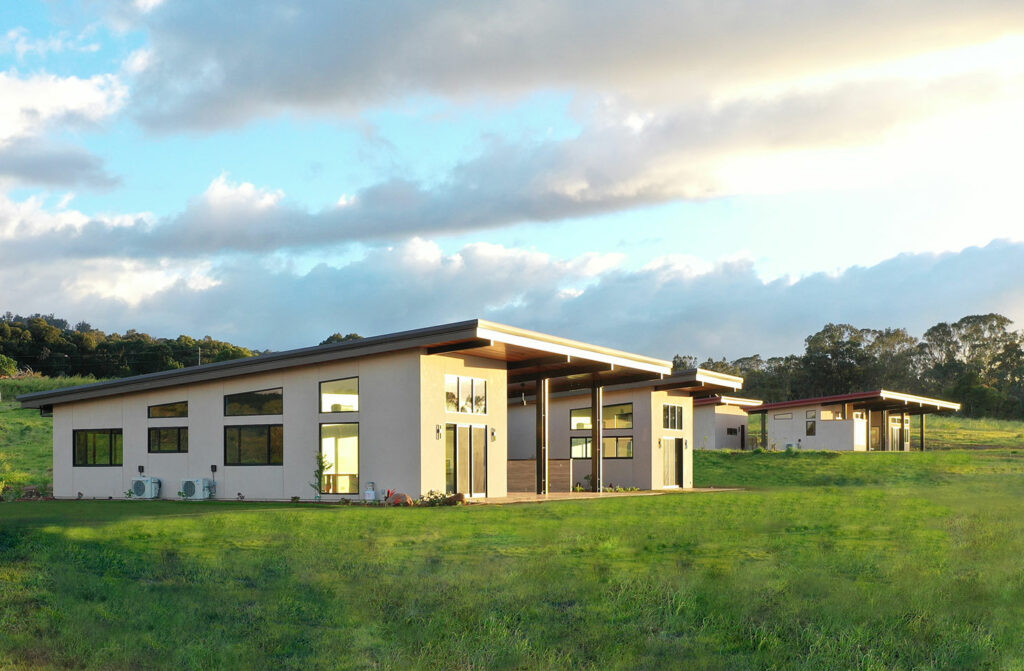
“Hōkū Nui is honored and excited to debut this cutting-edge project which we believe is the future of land management,” says Hammett. “We are happy to be leading the way in such a positive direction for Maui, Hawai‘i, the country and the world.”
HŌKŪ NUI LIVING
The overarching philosophy of Hōkū Nui is to balance environment, community and culture with financial viability. To that end, home sales will help perpetuate the community and all the activities therein. “The ideal Hōkū Nui homeowner is conscientious, environmentally supportive and wants to make a difference in the world with their home-ownership investment,” says Hammett.
There will be a total of 42 single-family structures (21 homes and 21 cottages) built in phases and sold by reservation. Each home sits on a one- to two-acre lot which is further surrounded by conservation-dedicated land, resulting in an “effective land area” of anywhere from two to 40 acres per home, depending on location. The gentle downslope of the property means that each home is all but guaranteed a view — whether it be of the ocean, the West Maui mountain, Haleakalā, Moloka‘i, or all of the above.
One home and one cottage have already been built and measure 3,200 and 1,000 square feet, respectively. The architecture seamlessly blends indoor and outdoor living with an easy, organic flow. In the main home, 10- to 15-foot ceilings and sturdy steel-beam supports give the space a contemporary, open feel, and poured-concrete floors deliver an overall polished — and low-maintenance — appeal. The main living area features a grand yet functional kitchen with a cooking island and waterfall countertop overlooking a large dining area with a two-sided gas fireplace — perfect for those chilly Upcountry nights. Opposite and outside, the fireplace again provides the focal point for the 1,000-plus square feet of exterior living space with room enough for your entire ‘ohana. Four bedrooms and three bathrooms flank the kitchen and outdoor area, and the master bedroom boasts a walk-in closet and a spa-worthy two-person outdoor shower and deep, luxurious soaker tub. Three-panel sliding glass doors open the master bedroom to the outdoors, and two tiers of windows mean brilliant light any time of day. A two-car garage finishes the package, and surrounding it all is drought-resistant landscaping.
The cottage is no less impressive, with a similar outdoor shower/bath combo off the master bedroom, and a 600-square-foot outdoor living space which separates the main house from the kitchen. This bonus “room,” if you will, does not count toward the 1,000 square feet of cleverly utilized interior living space, and nearly doubles the living area of the cottage. This home is also outfitted with the same oversize garage, as well as beautiful landscaping and the beginnings of a stand of bamboo in the backyard.
For more information on purchasing a home and being part of the Hōkū Nui community, go to NewHomesatHokuNui.com.

